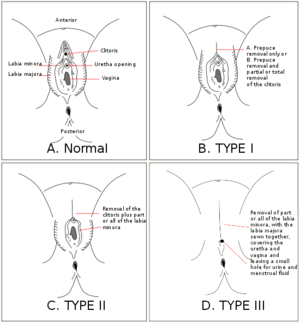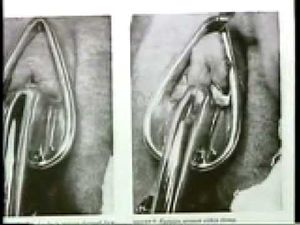Female circumcision
Female circumcision, also known as "female genital cutting" (FGC) or "female genital mutilation" (FGM) is a blanket term that can refer to a wide array of genital cutting performed in girls and women, performed for social, cultural and/or religious reasons.
Contents
History of female circumcision in the west
Female genital cutting (FGC) shares a strikingly similar history to male circumcision in Western medicine, being offered as a way to curb sexual activity, which was thought to cause disease.[1][2][3][4][5][6][7] In the US, female genital cutting was covered by Blue Shield until 1977. Today all forms of FGM are considered female genital mutilation (FGM), which are banned in all western countries.
The AAP briefly endorses female genital cutting
On April 26, 2010, the AAP changed its long-held stance of female genital cutting.[8] In their report, chiefly authored by Dena Davis, a professor at Cleveland-Marshall College of Law at Cleveland State University,[8] the AAP advised doctors to inform families that the procedure is medically unnecessary and even dangerous.[8] The AAP raised the idea of legalizing a less-severe ritual cutting, which they compared to an ear piercing,[8][9] the reasoning being that female circumcision had symbolic or ceremonial aspects for many parents,[9] and offering a "ritual nick" might dissuade parents that were resolute, from sending their daughters to their home countries,[8] thereby avoiding greater harm.[8] The AAP had deviated from a much more forceful statement published in 1998, which unequivocally condemned FGC in any form.[9]
The Girls Protection Act, which would make it illegal to take a minor outside the U.S. to seek female circumcision, was introduced in Congress on the same day the AAP published its new recommendation.[8] New York Representative Joseph Crowley, one of the bill's sponsors, condemned the AAP's move as "the wrong step forward on how best to protect young women and girls" by creating confusion about the acceptability of FGM in any form.[8] Davis of the AAP countered that such a law would be difficult to enforce.[8]
The AAP's endorsement of a "ritual nick" sparked a backlash[9] which was swift and universally negative. The AAP's recommendation had been perceived by many as a tacit endorsement of the "ritual nick," and an effort to appease parents who threatened to subject their daughters to worse procedures.[9] In short, the AAP was forced to retract its endorsement, and on May 1, Judith Palfrey, President of the AAP, released a statement that read in part, “the AAP does not endorse the practice of offering a ‘clitoral nick’. This minimal pinprick is forbidden under federal law and the AAP does not recommend it to its members.”[9] Palfrey reiterated this stance in an interview with The Lancet, saying “we want to make it clear to the international community we are opposed to any form of female genital cutting, and that includes the ritual nick.”[9] The AAP has since withdrawn the committee's report and has rewritten it completely.[9]
Variations of female genital cutting
FGC consists of several distinct procedures. Their severity is often viewed as dependent on how much genital tissue is cut away. The WHO — which uses the term Female Genital Mutilation (FGM) — divides the procedure into four major types[10] (see Diagram 1), although there is some debate as to whether all common forms of FGM fit into these four categories, as well as issues with the reliability of reported data.[11]

Type I
The WHO defines Type I FGM as the partial or total removal of the clitoral glans (clitoridectomy) and/or the prepuce (clitoral hood); see Diagram 1B. When it is important to distinguish between the variations of Type I cutting, the following subdivisions are proposed: Type Ia, removal of the clitoral hood or prepuce only; Type Ib, removal of the clitoral glans with the prepuce.[10]
Type II
The WHO's definition of Type II FGM is "partial or total removal of the clitoral glans and the labia minora, with or without excision of the labia majora. When it is important to distinguish between the major variations that have been documented, the following subdivisions are proposed: Type IIa, removal of the labia minora only; Type IIb, partial or total removal of the clitoral glans and the labia minora; Type IIc, partial or total removal of the clitoral glans, the labia minora and the labia majora.[10]
Type III: Infibulation with excision
The WHO defines Type III FGM as narrowing of the vaginal orifice with creation of a covering seal by cutting and repositioning the labia minora and/or the labia majora, with or without excision of the clitoral glans (infibulation)."[12] It is the most extensive form of FGM, and accounts for about 10% of all FGM procedures described from Africa.[13] Infibulation is also known as "pharaonic circumcision".[14]
Type IV: other types
There are other forms of FGM, collectively referred to as Type IV, that may not involve tissue removal. The WHO defines Type IV FGM as "all other harmful procedures to the female genitalia for non-medical purposes, for example, pricking, piercing, incising, scraping and cauterization."[10] This includes a diverse range of practices, such as pricking the clitoral glans with needles, burning or scarring the genitals as well as ripping or tearing of the vagina.[10]
External links
 Karaman MI. Female circumcision debate: A muslim surgeon’s perspective. Turk J Urol. 1 May 2021; 47(3): 193–8. DOI. Retrieved 30 April 2022.
Karaman MI. Female circumcision debate: A muslim surgeon’s perspective. Turk J Urol. 1 May 2021; 47(3): 193–8. DOI. Retrieved 30 April 2022.
References
- ↑ Kellogg, John Harvey
- ↑
 Morris RT. Is evolution trying to do away with the clitoris?. American Association of OB/GYNs. 5: 288-302.
Morris RT. Is evolution trying to do away with the clitoris?. American Association of OB/GYNs. 5: 288-302.
- ↑
 McFarland TS. Circumcision of Girls. Journal of Orificial Surgery. July 1898; 7: 31-33.
McFarland TS. Circumcision of Girls. Journal of Orificial Surgery. July 1898; 7: 31-33.
- ↑
 Dawson BE. Circumcision in the Female: Its Necessity and How to Perform It. American Journal of Clinical Medicine. June 1915; 22(66): 520-3. Retrieved 19 October 2021.
Dawson BE. Circumcision in the Female: Its Necessity and How to Perform It. American Journal of Clinical Medicine. June 1915; 22(66): 520-3. Retrieved 19 October 2021.
- ↑
 Eskridge BC. Why not circumcise the girl as well as the boy?. Texas State Journal of Medicine. May 1918; 14: 17-9.
Eskridge BC. Why not circumcise the girl as well as the boy?. Texas State Journal of Medicine. May 1918; 14: 17-9.
- ↑
 McDonald CF. Circumcision of the female. GP. September 1958; 18(3): 98-9. PMID. Retrieved 13 October 2021.
McDonald CF. Circumcision of the female. GP. September 1958; 18(3): 98-9. PMID. Retrieved 13 October 2021.
- ↑
 Rathmann WG. Female Circumcision: Indications and a New Technique. General Practitioner. September 1959; 20(9): 115-20. PMID. Retrieved 11 October 2021.
Rathmann WG. Female Circumcision: Indications and a New Technique. General Practitioner. September 1959; 20(9): 115-20. PMID. Retrieved 11 October 2021.
- ↑ a b c d e f g h i
 Luscombe, Belinda (11 May 2010)."Has a U.S. Pediatrics Group Condoned Genital Cutting?", Time. Retrieved 27 September 2011.
Luscombe, Belinda (11 May 2010)."Has a U.S. Pediatrics Group Condoned Genital Cutting?", Time. Retrieved 27 September 2011.
- ↑ a b c d e f g h
 MacReady N. AAP retracts statement on controversial procedure. The Lancet. 3 July 2010; 376(9734): 15. DOI. Retrieved 27 September 2011.
MacReady N. AAP retracts statement on controversial procedure. The Lancet. 3 July 2010; 376(9734): 15. DOI. Retrieved 27 September 2011.
- ↑ a b c d e
 Eliminating Female Genital Mutilation – An interagency statement OHCHR, UNAIDS, UNDP, UNECA, UNESCO, UNFPA, UNHCR, UNICEF, UNIFEM, WHO
Eliminating Female Genital Mutilation – An interagency statement OHCHR, UNAIDS, UNDP, UNECA, UNESCO, UNFPA, UNHCR, UNICEF, UNIFEM, WHO  , Department of Reproductive Health and Research (RHR), World Health Organization. (2008).
, Department of Reproductive Health and Research (RHR), World Health Organization. (2008).
- ↑
 Elmusharaf S, Elhadi N, Almroth L. Reliability of self reported form of female genital mutilation and WHO classification: cross sectional study. BMJ. 15 July 2006; 333(7559): 124. PMID. PMC. DOI.
Elmusharaf S, Elhadi N, Almroth L. Reliability of self reported form of female genital mutilation and WHO classification: cross sectional study. BMJ. 15 July 2006; 333(7559): 124. PMID. PMC. DOI.
- ↑ WHO, 2006-10-02
- ↑
 (1 June 2000).
(1 June 2000). Female genital mutilation
, World Health Organization. Retrieved 23 January 2008. - ↑ Frequently Asked Questions on Female Genital Mutilation (FGM)
